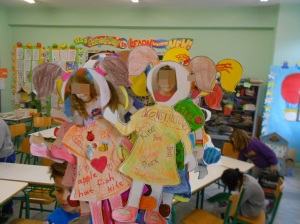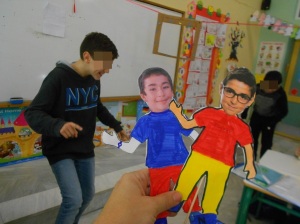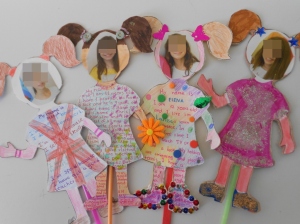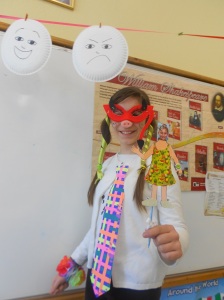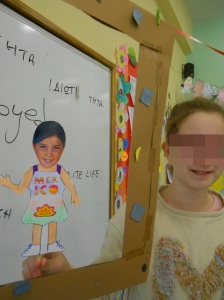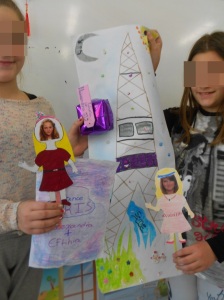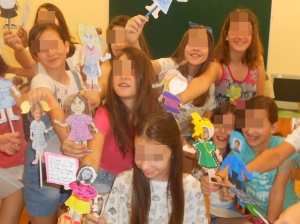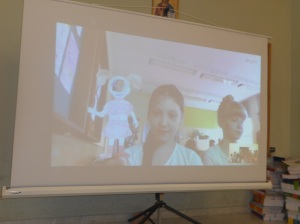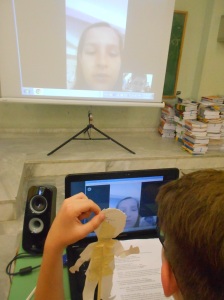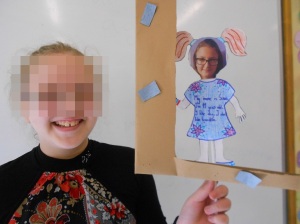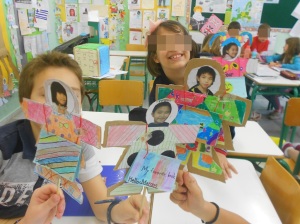Η φετινή μας απόπειρα, να εργαστούμε πάνω σε ένα νέο έργο στα πλαίσια του Teachers4Europe project, συνάντησε πολλά προβλήματα!…Το βασικότερο όλων, ήταν πως, δεν είχα ώρες, εκτός των ωρών της Αγγλικής Γλώσσας, για να εργαστώ! Σημειώστε εδώ πως, στα πλαίσια του μαθήματός μου, εργαζόμαστε ήδη σε άλλα δύο προγράμματα etwinning και ένα του Βρετανικού Συμβουλίου !
Πίεσα πάρα πολύ να μου δωθεί ΜΙΑ ώρα Ευέλικτης Ζώνης, ή άλλη, για να καταφέρω να ξεκινήσω, και αυτό κατέστη δυνατό, μόλις …πριν ένα μήνα!!
Τέλος καλό, όλα καλά λοιπόν, κι εδώ μπορώ σήμερα, να μοιραστώ το μεγαλύτερο μέρος της δουλειάς μας έως τώρα, η οποία δεν έχει ολοκληρωθεί ακόμη, αλλά θα ολοκληρωθεί, στο τέλος Μαίου!
Σκέφτηκα πολύ πάνω στην επιλογή θέματος , φέτος…
Τα πράγματα, στη χώρα, είναι κρίσιμα…οικονομική ανέχεια, κρίση αξιών, προσφυγικό και τόσα άλλα……Πολλοί κατηγορούν την Ευρώπη για όλα και δεν βλέπουν προοπτική πουθενά…
Σκέφτηκα λοιπόν πως, θα ήθελα να επιστρέψω στα βασικά…τις Ευρωπαικές αξίες και τον Ευρωπαικό πολιτισμό! Τα παιδια αυτά, οι σημερινοί μαθητές μου, θα είναι το μέλλον αυτής της Ευρώπης!
Χρειάζεται, να γνωρίσουν όλα τα θετικά της στοιχεία, όλα όσα μας κάνουν υπερήφανους και να την αγαπήσουν , να επιτρέψουν ως νέοι Ευρωπαίοι αργότερα στην πηγή του Ευρωπαικού πολιτισμού, κι από εκεί να δροσιστούν . Να εγκαταλείψουν ιδέες ξενοφοβίας και ρατσισμού και να ανακαλύψουν πως, αυτά που μας ενώνουν , είναι περισσότερα από αυτά που μας χωρίζουν!
Να δημιουργήσουν τέλος, την Ευρώπη των λαών και των πολιτισμών, αυτή την Ευρώπη που όλοι οραματιζόμαστε!
Το μύνημά μας στην Ευρώπη του σήμερα, αποφασίσαμε να είναι αυτό:
( “Ευρώπη, ν’ αγαπάς τους ανθρώπους” )
A “Teachers4Europe” project, 2015-16
Ε Τάξη, 30 Δημοτικό Σχολείο Λάρισας
Υπεύθυνη εκπαιδευτικός: Αφροδίτη Γκιούρη ( ΠΕ 06)
Σχεδιασμός Εργασίας
H ιδέα του συγκεκριμένου project, δημιουργήθηκε μετά το ταξίδι μου στις Βρυξέλλες πέρσυ, όταν επισκέφτηκα την υπαίθρια έκθεση Mini Europe δίπλα στο Atomium!
Σκέφτηκα τότε πως, σε δύσκολα χρόνια οικονομικής κρίσης για την πατρίδα μας και τις οικογένειες των μαθητών μου, σχεδόν κανένας τους δεν είναι πια δυνατό να ταξιδέψει στην Ευρώπη, ή τον κόσμο!
Αποφάσισα λοιπόν ,να…κλείσουμε όλη την Ευρώπη σε μικρά κουτιά , να τοποθετήσουμε σε αυτά όσους μικρούς “θησαυρούς” σχετικά με κάθε χώρα ανακαλύπταμε στα νοερά μας ταξίδια μέσα στην τάξη και να έχουμε έτσι τη δυνατότητα, να επισκεφτούμε με τη φαντασία μας, όσες φορές θέλουμε, την…μικρή-μεγάλη μας Ήπειρο!
Οι μικροί μας αυτοί “θησαυροί”, μπορούσαν να είναι: γνώσεις, εικόνες, κάρτες, βιβλία, μουσικές, συνταγές, ταξιδιωτικά ενθύμια-souvenirs, χρήματα, μνημεία, λέξεις, κι οτιδήποτε άλλο ένας αληθινός ταξιδιώτης έχει στις αποσκευές του και τις αναμνήσεις του μετά από ένα ταξίδι!
Τρόπος προσέγγισης στις αξίες και τους στόχους της ΕΕ
Ο βασικός σκοπός του project ήταν να βοηθήσει τους μαθητές να εμπλουτίσουν τις γνώσεις τους σχετικά με την Ευρώπη γενικά και ειδικότερα, σχετικά με τον σπουδαίο πολιτισμό της.
Κυρίως δε, με όσα στοιχεία αυτού του πολιτισμού , την καθιστούν μία Ήπειρο με κορμό της ύπαρξής της αξίες, δίχως τις οποίες η Ευρώπη δεν μπορεί να υφίσταται. Αυτές οι βασικές αξίες είναι : σεβασμός της ανθρώπινης αξιοπρέπειας, ισότητα και σεβασμός των ανθρώπινων δικαιωμάτων, δημοκρατία, ελευθερία.
Άλλος ένας στόχος, ήταν να ευαισθητοποιήσει τους μικρούς μαθητές , σε θέματα συνεργασίας και αλληλουποστήριξης, στα πλαίσια των ομαδικών δραστηριοτήτων, καθώς αυτές οι δύο έννοιες ,αποτελούν τον κορμό των Ευρωπαικών ιδεωδών .
Διδακτικές προσεγγίσεις που υιοθετήθηκαν
Η μεθοδολογία του project βασίστηκε σε προσεγγίσεις διαθεματικές , βιωματικές συνεργατικές, επικοινωνιακές καθώς και μάθησης με μέσο το παιχνίδι.
Με την ολοκλήρωση του project, ευελπιστώ πως οι μαθητές μου, έχουν γνωρίσει καλύτερα την Ευρώπη γεωγραφικά και κυρίως πολιτιστικά.
Κυρίως όμως , έχουν κατανοήσει τις βασικές αξίες που κρατούν τις Ευρωπαικές χώρες ενωμένες και το σημαντικό ρόλο που αυτές παίζουν στην καθημερινότητά μας. Έχουν επίσης κατανοήσει σε σημαντικό βαθμό, την σπουδαιότητα των εννοιών “ αποδοχή”, “ συνεργασία”, “σεβασμός”.
Εμπλοκή των μαθητών στη δράση
Οι μαθητές μου, επέδειξαν ζωηρό ενδιαφέρον για το project!
Ήταν μία τάξη που ποτέ πριν δεν είχε την ευκαιρία να λάβει μέρος σε παρόμοια δράση και είχε δυσκολίες ,εξ αρχής ,σε θέματα ομαδικής συνεργασίας .
Η δράση, ενίσχυσε το κομμάτι της ομαδικότητας και της αλληλουποστήριξης , καθώς και την δημιουργικότητα και την πρωτοβουλία των μαθητών.
Επίσης, τους δόθηκε η δυνατότητα να έχουν την εμπειρία της βιωματικής διδασκαλίας και διασκέδασαν εξαιρετικά ,με όσες δραστηριότητες είχανε σχέση με παιχνίδι και κίνηση!
Τέλος, είχανε μια μοναδική ευκαιρία να διευρύνουν τους ορίζοντές τους στον κόσμο και να γνωρίσουν την Ήπειρό μας, το Ευρωπαικό μας σπίτι, γεωγραφικά αλλά και πολιτιστικά.
Ήταν μία πολύτιμη εμπειρία για όλους !

Οι δραστηριότητες, σε σύντομη παρουσίαση
Δραστηριότητες warming-up
Γνωριμία με το βιβλίο “ Πάμε να εξερευνήσουμε την Ευρώπη”
Ξεφυλλίζουμε το βιβλίο και εργαζόμαστε σε ομάδες πάνω στο Quiz της σελίδας — και στο χάρτη της σελίδας —
Ενεργοποίηση «Το Τρένο της Ε.Ε.»
Ασκήσεις ενεργοποίησης και ισορροπίας των μελών του σώματος ατομικά. Καθένας είναι μια χώρα της Ε.Ε. Στη συνέχεια κινούνται ομαδικά σαν «Τρένο».
«Το Όχι αποκοιμήθηκε στην αγκαλιά του Ναι!»
Ζευγάρια. Ο ένας είναι το Όχι και ο άλλος το Ναι. Ξεκινούν με λεκτική επικοινωνία ο ένας λέει μόνο «Ναι» και ο άλλος μόνο «Όχι» και εξερευνούν διαφορετικούς τρόπους πχ ένταση, ταχύτητα κτλ. Στη συνέχεια οι λέξεις αποκτούν κίνηση και γίνονται χορός.
«Δράση- Αντίδραση. Λεκτικοί Ισχυρισμοί»
Σε τριάδες. Ένας είναι Παρατηρητής. Οι άλλοι δύο είναι απέναντι με απόσταση μεταξύ τους και με τον δικό του τρόπο ο καθένας, εκφράζουν εναλλάξ τις Αντίθετες Έννοιες πχ. Το έκανες!# Δεν το έκανα!, Το είπες!# Δεν το είπα! Κτλ. Συνεχίζεται μέχρι την κλιμάκωση της έντασης. Συζήτηση και καταγραφή των συναισθημάτων και των ρόλων που ανακύπτουν.
«Ευρωπαϊκό Ταγκό»
Ζευγάρια. Καθένας είναι μια χώρα της Ε.Ε. Ο ένας κλείνει τα μάτια του (τυφλός) κι ακολουθεί τις οδηγίες του ζευγαριού του. Όταν ο οδηγός- χορευτής τον ακουμπάει με την παλάμη του στον θώρακα τότε ο «τυφλός» χορευτής πηγαίνει μπροστά, όταν τον ακουμπάει στην πλάτη, πηγαίνει πίσω και ανάλογα όταν τον ακουμπάει στον δεξί ώμο πηγαίνει δεξιά κι αντίστοιχα στον αριστερό ώμο, αριστερά. Αλλάζουν ρόλους.
«Ε.Ε.: Η ισχύς εν τη ενώσει…»
Ομαδικό παιχνίδι. Όλοι πιάνονται από την μέση. Ο πρώτος έχει δαγκάνες και προσπαθεί/ διεκδικεί να πιάσει την ουρά, τον τελευταίο. Δεν πρέπει να σπάσει ο κορμός αλλά να παραμείνουν όλοι ισχυρά ενωμένοι μέχρι το τέλος!!!!
Βασικές δραστηριότητες
ACTIVITY 1
ΠΑΙΖΩ ΚΑΙ ΓΝΩΡΙΖΩ ΤΗΝ ΕΥΡΩΠΗ
Παίζουμε δύο παιχνίδια γνώσεων που αφορούν το χάρτη της Ευρώπης και τα μεγαλύτερα μνημεία της τα οποία δανειζόμαστε από το βιβλίο “Πάμε να εξερευνήσουμε την Ευρώπη” το οποίο υπάρχει από πέρυσι, στη βιβλιοθήκη του σχολείου.
ACTIVITY 2
ΣΚΥΤΑΛΟΔΡΟΜΙΑ ΣΤΟΝ ΕΥΡΩΠΑΙΚΟ ΧΑΡΤΗ
Αναρτούμε έναν χάρτη της Ευρώπης στον τοίχο.
Χωριζόμαστε σε 4 ομάδες. Ένας παίκτης από κάθε ομάδα, 4 παίχτες κάθε φορά, τρέχουν απο τον απέναντι τοίχο προς τον χάρτη, με σκοπό πρώτοι ν’ αγγίξουν τη χώρα το όνομα της οποίας , κάθε φορά ακούει να φωνάζει η εκπαιδευτικός, κερδίζοντας ένα βαθμό για την ομάδα του.
ACTIVITY 3
ΤΟ ΕΥΡΩΠΑΙΚΟ ΜΑΣ ΔΙΑΒΑΤΗΡΙΟ
Γνωριμία με το Βιβλιαράκι μας: Το “Ευρωπαικό μας Διαβατήριο” !
Είναι για μας ένα πολύ σημαντικό εργαλείο, καθώς, δεν υπάρχει εργαστήριο πληροφορικής και καθηγητής πληροφορικής στο σχολείο μας!
Χωριζόμαστε σε 4 ομάδες.
Σε κάθε ομάδα μαθητών , αντιστοιχεί μία ομάδα 7 χωρών, έπειτα από κλήρωση.
Διαδικασία
α) Οι ομάδες, συνεργάζονται για να κατασκευάσουν τις 7 σημαίες τους. Πίσω από κάθε σημαία, αναγράφονται 2 ερωτήσεις σχετικές με αυτή τη χώρα, τις οποίες οι μαθητές επιλέγουν.Οι σημαίες αυτές, χρησιμοποιούνται για να στολίσουν τα κουτιά κάθε χώρας και σε επόμενο μάθημα , στο “ Euro-καπελοπαιχνίδι” γνώσεων!
β) Στις ομάδες, δίνεται ο χάρτης της Ευρωπαικής Ένωσης σε κομμάτια παζλ. Καλούνται να συνεργαστούν, για να τον ανακατασκευάσουν σωστά , με πρότυπο τον χάρτη του Ευρωπαικού τους Διαβατηρίου, όσο πιο γρήγορα γίνεται! Η καλή συνεργασία, φέρνει και το καλύτερο δυνατό αποτέλεσμα!
γ) Κατασκευάζουνε, συνεργαζόμενοι, το βασικό αξιοθέατο της κάθε χώρας που έχουν αναλάβει ως ομάδα, σε χαρτί και χαρτόνι. Διαβάζουνε σχετικά με αυτό στο Ευρωπαικό μας διαβατήριο και γράφουμε βασικές πληροφορίες από πίσω από κάθε αξιοθέατο.
δ) Οι ομάδες, συνεργαζόμενες δημιουργούν σε χαρτί και χαρτόνι, κατασκευές που αναπαριστούν, στοιχεία σημαντικά από κάθε χωρα: το νόμισμα, κάποιες φράσεις στην γλώσσα της χώρας αυτής, συνταγές που έχουνε βρεί στο Διαβατήριο ή στο διαδίκτυο στο σπίτι τους κτλ
ε) Τους ζητείται, να φέρουν σε επόμενο μάθημα από το σπίτι τους, αφού ψάξουν και ρωτήσουν στο φιλικό κι οικογενειακό τους περιβάλλον, τυχόν αντικείμενα, που προέρχονται από αυτή τη χώρα : souvenirs, μία κάρτα, ένα γραμματόσημο, νομίσματα, εικόνες διάσημων ανθρώπων από κάθε χώρα αλλά και Cds μουσικής γνωστών μουσικών , ταινίες , βιβλία, φωτογραφίες, δώρα, περιοδικά με σχετικές δημοσιεύσεις, ακόμη και είδη διατροφής, εάν υπάρξουν…οτιδήποτε θελήσουν να φέρουν στη τάξη!
Επίσης, τους ζητείται να φέρουν ένα κουτί παπουτσιών για κάθε μία από τις 7 χώρες της ομάδας τους.
ζ) Τέλος, εργαζόμενοι σε ζευγάρια, μέσα σε κάθε ομάδα, στολίζουν με τις σημαίες των χωρών, κάθε κουτί παπουτσιών που έχουν φέρει από το σπίτι, και τοποθετούν μέσα σε αυτό, όσους μικρούς “ θησαυρούς”, έχουν καταφέρει να συγκεντρώσουν και να κατασκευάσουν στην τάξη!
Συζητούν σχετικά με τον τρόπο που επιθυμούν να παρουσιάσουν το υλικό τους και όλα όσα θα ήθελαν να μοιραστούν με τις άλλες ομάδες σχετικά με την κάθε χώρα!
ACTIVITY 4
ΠΑΡΟΥΣΙΑΣΗ ΧΩΡΩΝ :EUROPE IN A BOX
Οι κάθε ομάδα, χωρίζεται σε ζευγάρια, τα οποία παρουσιάζουν το περιέχόμενο των κουτιών τους στους συμμαθητές τους, με τον τρόπο που επιθυμούν! Ακολουθούν διευκρινιστικές ερωτήσεις από την τάξη, σε κάθε ομάδα.
ACTIVITY 5
ΑΝΑΤΡΟΦΟΔΟΤΗΣΗ-ΣΥΖΗΤΗΣΗ-ΕΝΤΥΠΩΣΕΙΣ
Ακολουθεί συζήτηση, σχολιασμός της όλης εμπειρίας, μοίρασμα συναισθημάτων και σκέψεων, γνώμες και εντυπώσεις.
ACTIVITY 6
ΠΑΙΧΝΙΔΙΑ ΕΜΠΕΔΩΣΗΣ
α)TIC-TAK BOOM
Χρησιμοποιούμε ως βάση το γνωστό παιχνίδι Tic-tak boom!
Ένας παίκτης από κάθε ομάδα, έρχεται στον πίνακα ,φορά ένα καπέλο με το όνομα μίας από τις Ευρωπαικές χώρες και οι συμπαίκτες του στην ομάδα, του δίνουν όσες περισσότερες πληροφορίες μπορούν γι’ αυτή τη χώρα, μέσα σε ορισμένο χρόνο -ώσπου να..σκασει η “ βομβα” του χρονόμετρου!
Χρησιμοποιούν το Ευρωπαικό μας Διαβατήριο για πληροφορίες .
Εάν ο παίκτης, καταφέρει πριν τη λήξη του χρόνου, να βρει το όνομα της χώρας που υπάρχει στο καπέλλο του, κερδίζει ένα βαθμό για την ομάδα του!
Το παιχνίδι ολοκληρώνεται, όταν παίξουν όλα τα μέλη και των 4 ομάδων.
Οι νικητές , παίρνουν μικρά αυτοκόλλητα με ευρωπαικές σημαίες!
β) TWISTER
Βάση μας, το γνωστό παιχνίδι Twister.
Ένας παίκτης από κάθε μία από τις 4 ομάδες μας, εκπροσωπεί την ομάδα του σε κάθε γύρο του παιχνιδιού.
Σε κάθε έναν από τους χρωματιστούς κύκλους της βάσης του παιχνιδιού, τοποθετείται μία πλαστικοποιημένη Ευρωπαική σημαία.
Η εκπαιδευτικός, γυρνά το spinner και οι 4 μαθητές , πρέπει να τοποθετούν τα χέρια ή τα πόδια τους κάθε φορά στο σωστό κύκλο.
‘Οποιος κάνει λαθος, βγαίνει απο το παιχνίδι και νικητής σε κάθε γύρο είναι αυτος που μένει τελευταίος, κερδίζοντας ένα βαθμό για την ομάδα του.
Το παιχνίδι ολοκληρώνεται, όταν παίξουν όλα τα μέλη και των 4 ομάδων.
Οι νικητές , παίρνουν μικρά αυτοκόλλητα με ευρωπαικές σημαίες!
γ) Το Euro-καπελοπαιχνίδι
Ένας παίκτης από κάθε ομάδα, έρχεται κάθε φορα στον πίνακα, κρατώντας από μία σημαία από αυτές που είχανε κατασκευάσει οι ομάδες σε προηγούμενο στάδιο, πίσω από τις οποίες , αναγράφονται δύο ερωτήσεις σχετικές με την χώρα.
Ο παίκτης, διαβάζει δυνατά, μία απο τις ερωτήσεις πάνω στη σημαία του, και οι άλλες ομάδες ΠΛΗΝ της δικής του, προσπαθούν συνεργαζόμενες κι ανατρέχοντας στο μικρο Ευρωπαικό μας Διαβατήριο, να βρούνε την απάντηση πρώτες, πριν τις υπόλοιπες ομάδες.
Το παιχνίδι ολοκληρώνεται, όταν παίξουν όλα τα μέλη και των 4 ομάδων
Η πρώτη ομάδα, σε ταχύτητα και αποτελεσματική συνεργασία , μετά την ολοκλήρωση του παιχνιδιού, κερδίζει πάλι, σημαίες σε αυτοκόλλητα!
δ) MEMORY GAME
Πρώτο Στάδιο:
‘Ολες οι σημαίες των χωρών, όλων των ομάδων , τοποθετούνται στο πάτωμα . Επίσης, στο πάτωμα τοποθετούνται χαρτάκια στο μέγεθος των σημαιών, με τα ονόματα των Ευρωπαικών χωρών.
Ένας παίκτης κάθε φορά, εκπροσωπώντας την ομάδα του, πρέπει να ταιριάξει ένα όνομα και την αντίστοιχη σημαία με επιτυχία! Εάν τα καταφέρει, κερδίζει τη σημαία. Εάν όχι, την αφήνει στο ίδιο σημείο και επόμενος παίκτης, επόμενης ομάδας ακολουθεί.
Η ομάδα με τις περισσότερες σημαίες στην κατοχή της, είναι η νικήτρια ομάδα!
Παραλαγή -Αντί για σημαίες, μπορούμε να εργαστούμε με χαρτάκια πάνω στα οποία υπάρχουν οι λέξεις-χαιρετσμοί σε κάθε γλώσσα, τις οποίες πρέπει να τις ταιριάξουν με τα ονόματα των χωρών με τον ίδιο τρόπο.
Δεύτερο Στάδιο:
Διαφορετικοί Χαιρετισμοί
Εξηγούμε στα παιδιά ότι συχνά οι άνθρωποι χαιρετιούνται από τόπο σε τόπο με διαφορετικό τρόπο στην Ευρώπη. Έτσι, τους προτείνουμε να χωριστούν σε ζευγάρια και να δικομάσουμε διαφορετικούς τρόπους χαιρετισμού: π.χ. Ελλάδα, Αλβανία, Ιταλία, Σουηδία, Γερμανία, Γαλλία, Ισπανία.
Όσο διαρκεί η μουσική χορεύουν , όταν σταματά πρέπει να βρουν κάποιον και να τον χαιρετίσουν ανάλογα με την εντολή μας.
ACTIVITY 7
H ΣΗΜΑΙΑ ΤΩΝ ΑΣΤΕΡΙΩΝ
α)Διαβάζουμε το βιβλίο “ Τα Αστέρια της Ευρώπης”.
Στη διάρκεια της ανάγνωσης, οι ομάδες κρατάνε σημειώσεις και γράφουν ιδέες οι οποίες τους άρεσαν στην ιστορία.
Κατόπι, συζητάμε όλοι μαζί στην τάξη, για όλα όσα κατέγραψαν.
Τονίζονται οι ιδέες που αφορούν τις θεμελιώδεις Ευρωπαικές αξίες όπως η Αλληλεγγύη και η Ειρήνη!
Καταγράφουμε τις σημαντικότερες ιδέες, στον πίνακα .
Δίνεται σε κάθε ομάδα, ένα χαρτί Α3 στο οποίο καλούνται όλοι να αντιγράψουν τις 12 σημαντικότερες -κατά την ομάδα τους – Ευρωπαικές αξίες, σε κάθε ένα από τα 12 αστέρια της Ευρωπαικής Σημαίας.
Στο τελευταίο στάδιο, οι ομάδες, πάλι συνεργαζόμενες, χρωματίζουν τη σημαία τους!
Όλες οι Σημαίες των Αστεριών, στολίζουν τους τοίχους της τάξης!
β) Ετοιμάζουμε το δικό μας μικρό θεατρικό, βασιζόμενο στην ιστορία.
Οι μαθητές, εργαζόμενοι σε ομάδες των 5-6 ατόμων, γράφουν το δικό τους μικρό θεατρικό δρώμενο με ηρωίδα την Ευρώπη, και το παρουσιάζουν στην τάξη αργότερα, για τους συμμαθητές τους.
Χρησιμοποιούν τη φαντασία τους δημιουργικά, στη διάρκεια της συγγραφής και ενθαρρύνονται να αυτοσχεδιάσουν στη διάρκεια της μικρής τους παράστασης.
FINAL -OPTIONAL-ACTIVITY
Με το τέλος της σχολικής χρονιάς και την ολοκλήρωση του project, στόχος μας είναι να μπορέσουμε σε συνεργασία με το Σύλλογο γονέων, είτε να αγοράσουμε permanent markers και να ζωγραφίσουμε σε λευκά μπλουζάκια την Ευρωπαικη σημαία, είτε να παραγγείλουμε σε κατάστημα την εκτύπωση των Σημαιών των Αστεριών μας, σε μπλουζάκια μέσω επεξεργασίας σε υπολογιστή.
(An English version, will follow soon…Stay tuned!)










































































































































